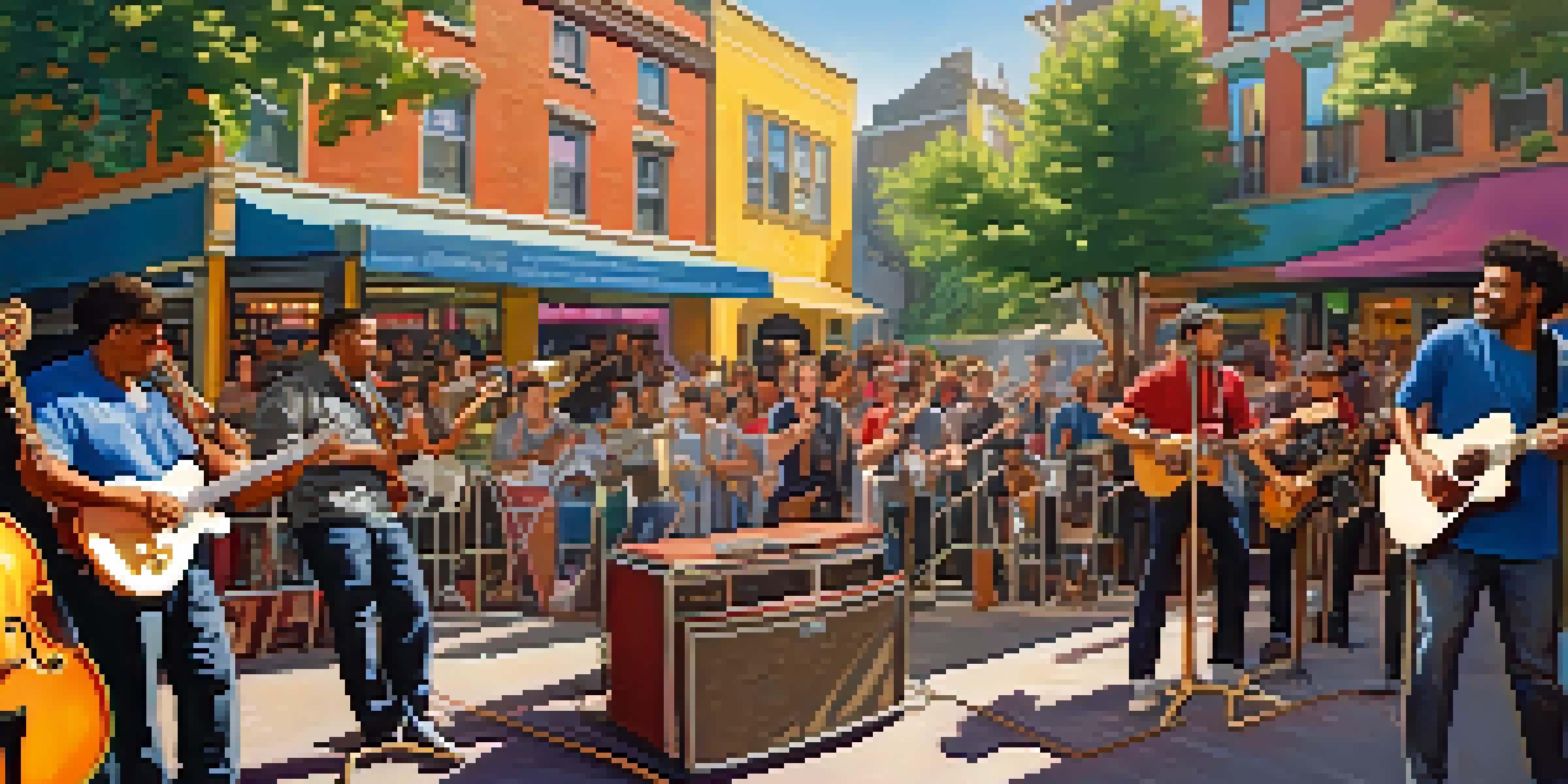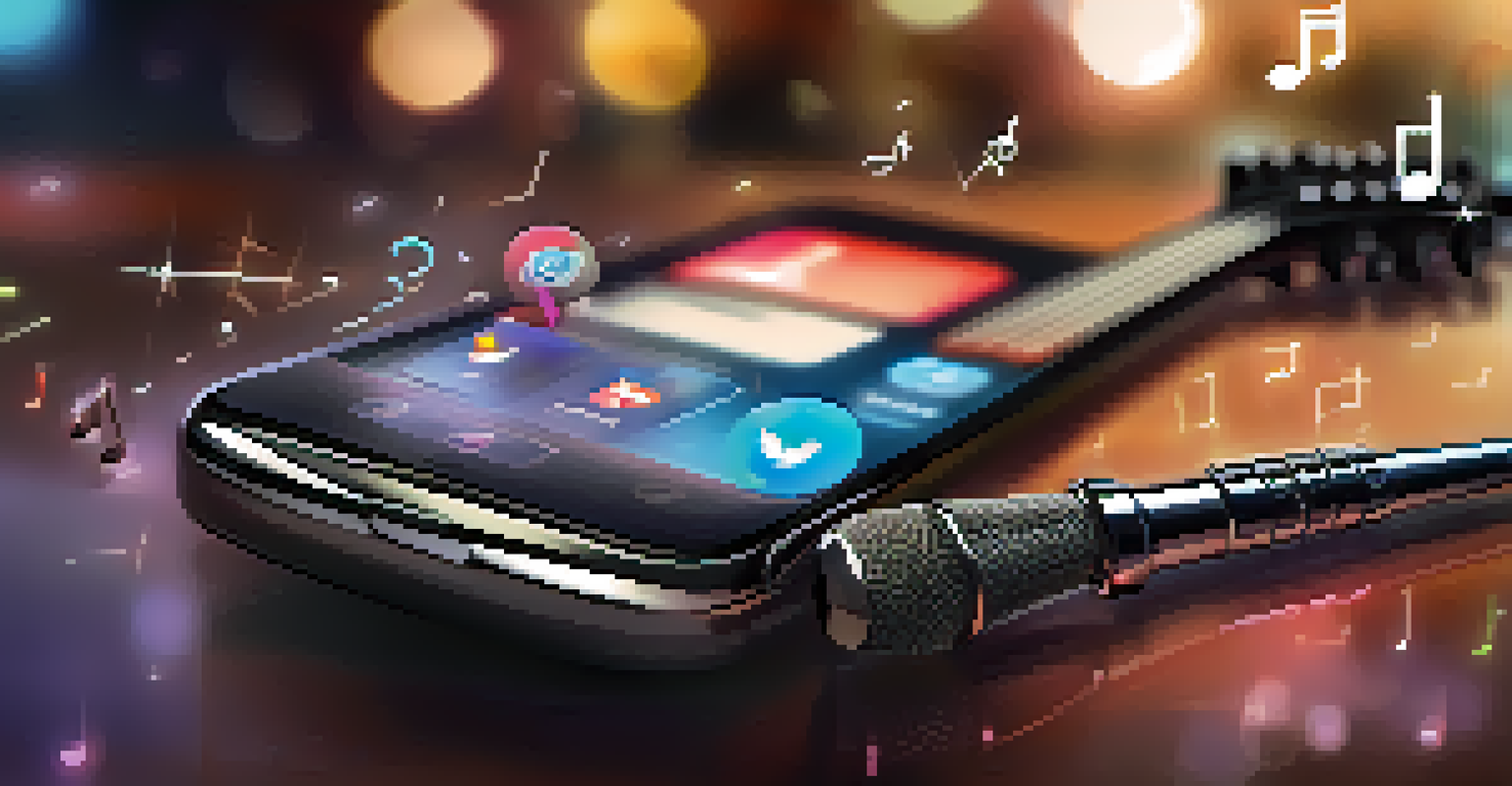The Role of Social Media Platforms in Music Distribution Today

Social Media Platforms: Gatekeepers of Music Distribution
In today's music industry, social media platforms have become the new gatekeepers. Gone are the days when artists relied solely on record labels to get their music heard. Now, platforms like Spotify, YouTube, and SoundCloud allow musicians to directly reach their audience, democratizing music distribution.
Music is the shorthand of emotion.
With just a few clicks, an artist can upload a track and share it across various channels, instantly connecting with fans around the globe. This shift not only empowers independent artists but also creates a more diverse music landscape, where sounds from different cultures and backgrounds can flourish.
For instance, an indie artist in a small town can gain a following on social media, leading to opportunities that were previously unimaginable. This transformation illustrates how social media has turned traditional distribution models on their heads, making music more accessible than ever.
Building a Music Brand through Social Engagement
Social media isn’t just about sharing music; it’s about building a brand. Artists today understand that their online presence is crucial for success. By engaging with followers through posts, live streams, and stories, musicians create a personal connection that fosters loyalty and encourages more fans to share their work.

For example, many artists use platforms like Instagram and TikTok to share behind-the-scenes content, giving fans a glimpse into their creative process. This transparency not only enhances the fans’ experience but also makes the artist more relatable and approachable.
Social Media Empowers Artists
Platforms like Spotify and YouTube enable musicians to connect directly with audiences, democratizing music distribution.
Moreover, these interactions often lead to organic growth as fans become advocates for the artist, sharing their music within their own networks. This grassroots approach to marketing highlights the importance of social engagement in today’s music distribution landscape.
The Role of Viral Trends in Music Promotion
Viral trends have become a powerful tool in music promotion, thanks in large part to platforms like TikTok. A catchy snippet of a song can explode overnight, leading to millions of streams and downloads. This phenomenon underscores the unpredictable nature of social media, where a single post can catapult an unknown artist to fame.
The future of music is in the hands of the artists themselves.
Take the example of Lil Nas X’s 'Old Town Road,' which gained massive popularity after a viral TikTok challenge. Such trends not only boost the artist's visibility but also create a sense of community among listeners, as they share and participate in the trend together.
This highlights a new reality: music distribution is no longer just about releasing a song; it’s about leveraging viral moments to engage audiences. Artists who can tap into these trends are often the ones who thrive in the fast-paced digital landscape.
Data Insights: Understanding Your Audience
One of the significant advantages of social media is the data it provides artists about their audience. Platforms offer insights into who is listening, where they are located, and what content resonates with them. This information allows musicians to tailor their marketing strategies effectively.
For instance, if an artist notices a spike in listeners from a particular city, they might consider scheduling a concert there. This data-driven approach not only optimizes their outreach but also strengthens their connection with fans by acknowledging their interests.
Engagement Builds Artist Loyalty
By interacting with fans through social media, artists foster personal connections that encourage fan advocacy and sharing.
Moreover, understanding audience demographics can help artists create content that truly speaks to their fans, whether it’s through targeted ads or personalized messages. In essence, social media serves as a valuable tool for artists to navigate and enhance their music distribution strategies.
Collaborations Amplified by Social Media
Social media has also transformed how artists collaborate with one another. In the past, collaborations often required intermediaries like record labels to facilitate introductions. Now, artists can connect directly through platforms like Twitter and Instagram, leading to spontaneous and innovative partnerships.
For example, many emerging artists find inspiration by engaging with others in their genre on social media. These collaborations can lead to unique sound fusions, attracting diverse audiences and enhancing the artists' visibility.
Additionally, collaborations often generate buzz on social media, encouraging fans from both artists to engage with the new content. This interconnected community highlights how social media serves as a catalyst for creative partnerships in the music industry.
Monetization Opportunities on Social Media Platforms
Monetization has become a focal point for artists leveraging social media as a distribution channel. Platforms like YouTube and Instagram now offer ways for musicians to earn revenue directly from their content. This includes ad revenue, merchandise sales, and even fan subscriptions.
For instance, artists can host exclusive live performances for their followers on platforms like Patreon, offering a more intimate experience while generating income. This shift allows musicians to diversify their revenue streams beyond traditional album sales and concert tickets.
Data Insights Enhance Strategy
Social media provides valuable audience data that allows artists to tailor their marketing strategies effectively.
Moreover, as platforms continue to evolve, new monetization options are likely to arise, providing even more opportunities for artists to sustain themselves financially in a competitive landscape. This evolution highlights the importance of social media as a viable income source for modern musicians.
Challenges of Music Distribution via Social Media
Despite the advantages, distributing music via social media comes with its own set of challenges. The sheer volume of content can make it difficult for artists to stand out. With countless new releases daily, capturing audience attention requires creativity and strategic planning.
Additionally, algorithms on platforms can be unpredictable, affecting an artist's visibility. An artist may post a fantastic track, but if the algorithm doesn’t favor it, the music may go unnoticed. This reality underscores the need for artists to remain adaptable and proactive in their promotional strategies.

Furthermore, the pressure to constantly create engaging content can lead to burnout. Artists must balance their creative process with the demands of social media, which can be a daunting task. Recognizing and addressing these challenges is essential for sustainable success in the digital music era.